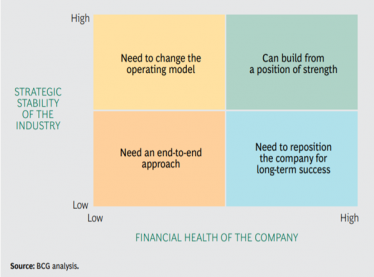There is nothing more difficult to take in hand, more perilous to conduct, or more uncertain in its success, than to take the lead in the introduction of a new order of things.”
– Niccolo Machiavelli
As we witness ever increasing disruption in the industries with accelerated changes, transformation has become an integral part of the global organization. Assessing the health of our businesses and aligning the business resources to the evolving business needs will allow organizations in delivering and sustaining breakthrough performance imperatives to address disruption, create strong and sustainable value or fulfil the organization’s purpose.
Look before you leap: Assessing the need for business transformation
Increased volatility, digital disruption, increasing regulation, geopolitical complex situation, public-spending pressure, manufacturing economics, energy dynamic and variable rates of growth are just a few examples of the factors affecting businesses and the need to know if an organization should consider transformation initiatives.
Well known strategy consulting firms have developed various frameworks to help organizations assess the need for a business transformation,
A model developed by Boston Consulting Group (BCG) that considers both internal and external factors affecting a company by mapping the financial health of a company and the stability of the industry is noteworthy. The four quadrants listed in Exhibit: A gives a clear view into how an organization can benefit from transformation.
 Exhibit: A
Exhibit: A
While a business with poor financial performance would need immediate attention to boost liquidity and build transformation programs to address that critical situation; successful companies with high financial performance will more often need to monitor changing market scenarios and reshape the strategy for shareholder value creation. Other factors that would need to be factored in can include leadership, people, and capabilities in place to deliver and sustain performance.
Other reputed consulting firms also rely on ‘change’ as their focus of business transformation need and have slightly different approaches to assess the need. For example, Deloitte suggests an agile approach involving seeing, doing and delivering differently with the model focusing on 7 unique phases: Sense- Frame- Decide-Design -Refine- Scale- Sustain.
McKinsey on the other hand focuses on a comprehensive, highly disciplined transformation methodology including the “what” and “how” phases.
Whatever model we might choose to emulate, every model is focused on changing the ways an organization functions and relooking at the different scenarios that impacts businesses- be it people, process or tools. This will need to address a huge shift in the way leaders in the organization engage with their team members for the transformation to be successful.
Below are a few important pointers we need to consider before leaping into business transformation within organizations
- Bias: McKinsey senior partner Kevin Laczkowski emphasizes leaders encounter many challenges during transformation initiatives. Many ideas may be generated within a company, but there may be no alignment on which ones can impact value creation and which ones to take forward for execution. Biases in the organization management such as the legacy bias (of continuing things that been done in a certain way in the past) can hinder the transformation program at its very outset.
- Finance/funding: Financing business transformation programs turns out to be one of the biggest challenges that any leader would have to face. In a performance transformation, normally the financial impact is rapid which makes a self-subsidizing model. In other cases, it can require significant time or a significant funding. Regardless of whether it’s the presentation of new products, venturing into new markets, changing business models, or putting resources into digital capabilities – these vital moves normally require upfront funding before understanding the financial advantage.
- Leadership skills: Leadership builds conviction and responsibility towards change. An alignment of the executive board members on the transformation initiatives is a must as leaders are often the first ones to notice industry disruptions and would need to act in time. Transformation leaders can fabricate outcomes by testing all the potential moves against their possible outcomes through detailed scenario planning, data and experience supported models. Below are a few steps that leaders should consider that can enhance the possibilities of a successful transformation.
- Analyze and Align: Analyze the current situation and align on goals and objectives with the stakeholders – both internal and external. Developing an initial hypothesis on value creation, having an impactful plan of action, clarity on business case for change are just a few things to start with.
- Garner Support:Some strategic transformations can impact revenues in the initial phase for which the board (of directors) should be in complete alignment. Further, engaging with employees about change readiness and embracing the change is important. Once a roadmap is developed, map clear milestones, resource allocation, team formations, communication plan and other such initiatives well I advance.
- Focus and Execute in Steps: One should focus on getting the quick wins through the pilot or short-term results and then plan for initiatives in the medium term. It is important to execute and sustain the transformation and to make a few major, striking moves all through the transformation journey.
- Be Directive and Inclusive: A transformative leader should be both- directive and inclusive. Directive leadership maps vision and strategic priorities, initiates transformation aim and milestones and builds accountability within the transformation team. Inclusive leadership involves the transformation team early on and focus on teamwork and mobilizes and empowers the teams and is also open to feedback from the teams.
- Sustainability: Organizations need to adhere to the transformation plan and not celebrate wins early in the transformation journey. Further, the organization needs to reinvest in the transformation roadmap continuously developing innovative ideas and observing an iterative model of key success indicator measurement and course correction for achieving planned results. Organizations that are best in executing changes are those that constantly reinvest in their transformation pipeline. Organizational wellbeing should also be focused along with these transformation programs.
Various companies have successfully transformed their business by combining above transformation strategies that fits in with their goals. Here’s a peek into a few case studies on successful business transformations that can be inspiring
.
Case Study 1:
Tata Motors successfully implemented multiple business transformation programs. It focused on factors such as technology upgrade, effective utilization of resources, efficient management of acquisitions, ability to develop partnerships, resource sharing, and innovations. It was effectively able to transform its business from commercial vehicle to passenger vehicle segment. Tata Motors focused on asset creation and asset seeking ability wherein they performed acquisition of global brands such as Land Rover and Jaguar, Daewoo and Hispano Carrocera.
‘FUTUREADY’ Stepping up the game strategy included new product development as per global design standards with Impact 2.0. They focused on new opportunities and shifted customer needs by offering innovative new products more frequently and modifying existing models based on market trends. New technology helped them in reducing rejection and rework creating robust quality products raising their brand value. Scale increase was possible by focusing on productivity through modularity, using common platforms for different products, focus on ‘Dealer Centre of Excellence’ in SCV and ‘Go to Market Excellence’, production quality focus and rigorous cost reduction initiatives. There were extensive changes made in supply chains and extending their delivery channels globally helped them gain global momentum and operational competitiveness.
They expanded globally with innovative technology-based vehicles increasing their brand value and profits. The performance of the company saw a sudden rise in its global share with a 17.2% YOY volume and 20.3% YOY revenue growth in its
FY 2018 results.
Case Study 2:
Microsoft: Microsoft transformed from selling products, licenses (IP) and devices to a cloud-based platform as-a-service business. The Intelligent Cloud Business at Microsoft consists of public, private and hybrid server products and cloud services and Microsoft Azure has been the impetus that drives this development. Microsoft also focused its resources in exploring AI and AR/VR technologies. Across the entire customer value chain, Microsoft started its offerings to take on opportunities in the competitive ‘red ocean’ but also capture
‘blue ocean’ uncontested space. Microsoft CEO Satya Nadella managed legacy bias and challenges by reorganizing the Microsoft over a period of time and shifting priorities.
Nadella in his first letter to his employees wrote on future Microsoft’s strategy: “I believe over the next decade computing will become even more ubiquitous and intelligence will become ambient. The coevolution of software and new hardware form factors will intermediate and digitize — many of the things we do and experience in business, life and our world. This will be made possible by an ever-growing network of connected devices, incredible computing capacity from the cloud, insights from big data, and intelligence from machine learning. We need to prioritize innovation that is centered on our core value of empowering users and organizations to “do more.” We have picked a set of high-value activities as part of our One Microsoft strategy. And with every service and device launch going forward we need to bring more innovation to bear around these scenarios. Many companies aspire to change the world. But very few have all the elements required: talent, resources, and perseverance. Microsoft has proven that it has all three in abundance. And as the new CEO, I can’t ask for a better foundation.”
Microsoft worked towards more integrated offerings and addressed the pain points of its customers. Over time, it became synonymous with flexibile and easy to use platforms making its customers and vendors happy. Microsoft also focused on aggressive big and small acquisitions namely LinkedIn and GitHub.
In
fiscal year 2018 results, Commercial cloud income expanded by 56% to $23.3B, inside which server items and cloud services income expanded by 21% due to Azure income surge of 91%. Overall revenue expanded by 76.6% from 2010 to 2018.
Learning from mistakes
“It’s good to learn from your mistakes. It’s better to learn from other people’s mistakes.”
— Warren Buffet
It is important to understand that not all business transformation initiatives succeed. According to
Economic Intelligence unit failures of transformation initiatives happens mostly due to lack of clearly defined and achievable milestones and objectives to measure progress. Other major reasons include lack of commitment by senior management and employee resistance followed by a poor communication strategy.
Therefore, if an organization feels the need to undergo business transformation in order to align itself with the various changes in the market and stay competitive, it is essential to be mindful of the model it wants to follow and avoid the above common mistakes that leads to business transformation failures. Being agile and responsive to issues that arise while one analyzes, accepts and embraces the changes based on a planned strategy and the skill of the professionals leading the change goes a long way in ensuring a successful business transformation efficiently.
 Exhibit: A
While a business with poor financial performance would need immediate attention to boost liquidity and build transformation programs to address that critical situation; successful companies with high financial performance will more often need to monitor changing market scenarios and reshape the strategy for shareholder value creation. Other factors that would need to be factored in can include leadership, people, and capabilities in place to deliver and sustain performance.
Other reputed consulting firms also rely on ‘change’ as their focus of business transformation need and have slightly different approaches to assess the need. For example, Deloitte suggests an agile approach involving seeing, doing and delivering differently with the model focusing on 7 unique phases: Sense- Frame- Decide-Design -Refine- Scale- Sustain.
McKinsey on the other hand focuses on a comprehensive, highly disciplined transformation methodology including the “what” and “how” phases.
Whatever model we might choose to emulate, every model is focused on changing the ways an organization functions and relooking at the different scenarios that impacts businesses- be it people, process or tools. This will need to address a huge shift in the way leaders in the organization engage with their team members for the transformation to be successful.
Exhibit: A
While a business with poor financial performance would need immediate attention to boost liquidity and build transformation programs to address that critical situation; successful companies with high financial performance will more often need to monitor changing market scenarios and reshape the strategy for shareholder value creation. Other factors that would need to be factored in can include leadership, people, and capabilities in place to deliver and sustain performance.
Other reputed consulting firms also rely on ‘change’ as their focus of business transformation need and have slightly different approaches to assess the need. For example, Deloitte suggests an agile approach involving seeing, doing and delivering differently with the model focusing on 7 unique phases: Sense- Frame- Decide-Design -Refine- Scale- Sustain.
McKinsey on the other hand focuses on a comprehensive, highly disciplined transformation methodology including the “what” and “how” phases.
Whatever model we might choose to emulate, every model is focused on changing the ways an organization functions and relooking at the different scenarios that impacts businesses- be it people, process or tools. This will need to address a huge shift in the way leaders in the organization engage with their team members for the transformation to be successful.

